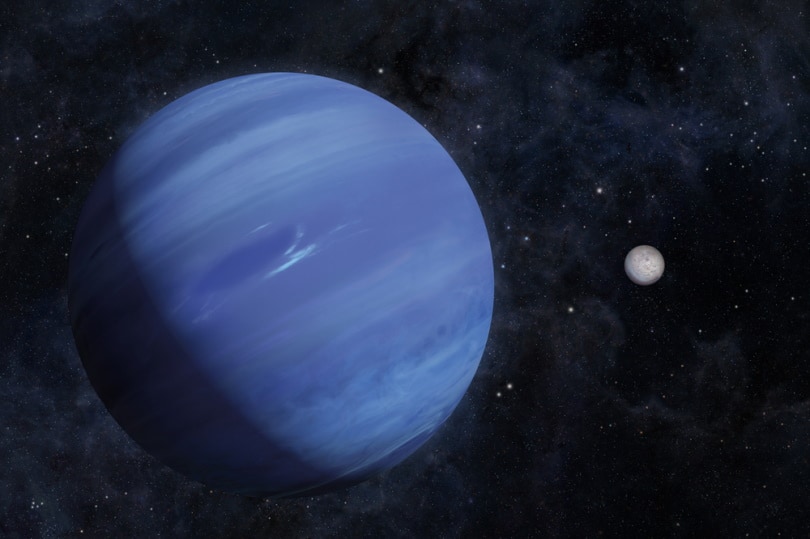How Many Moons Does Neptune Have?
Last Updated on

Whereas Earth only has one moon, Neptune1 has a total of 14 moons. Although 14 moons may sound excessive to us mere Earthlings, there are actually three other planets that have more moons than Neptune.
To learn more about Neptune’s moons, keep reading. This article takes a look at why Neptune has so many moons, the interesting moon Triton, and how Neptune’s moons compared to other planets. Scroll down for all of this and more.

How Moons Does Neptune Have?
As of 2022, Neptune has a total of 14 moons. The first moon, Triton, is both Neptune’s first spotted moon and its largest moon. Triton was spotted just 17 days after a Berlin observatory found Neptune. Here are the names of Neptune’s 14 moons:
- Despina
- Galatea
- Halimede
- Hippocamp
- Laomedeia
- Larissa
- Naiad
- Nereid
- Neso
- Proteus
- Psamathe
- Sao
- Thalassa
- Triton
About Triton
Of these 14 moons, Triton is one of the most interesting. In fact, Triton is one of the most interesting moons in the entire Solar System.
Triton was found on October 10th, 1846, just 17 days after the planet Neptune was discovered. Out of Neptune’s 14 moons, Triton is the largest. The size is not what makes Triton so interesting, though. In our Solar System, every single moon orbits in the same direction of the planet’s rotation. Triton is the one exception.
Unlike all the other large moons in our Solar System, Triton actually orbits in the opposite direction of Neptune’s rotation. In more scientific terms, Triton has a retrograde orbit.
More interesting is the fact that scientists believe that Triton came from the Kuiper belt millions of years ago. The Kuiper belt is also responsible for Pluto. Scientists have made this assertion on the fact that the moon Triton has many similarities with Pluto.

Why Does Neptune Have So Many Moons?
Since Earth only has one moon, you might be wondering why Neptune has 14 in total.
The short answer is that the larger the planet is, the stronger its gravitational field will be. Whenever a planet has a strong gravitational field, it is able to pull moons into its orbit. The stronger the field, the more moons can be pulled in.
What this tells us is that Neptune has a stronger gravitational field than Earth. As a result, it has pulled in more satellites or moons than Earth simply because it has a stronger pull.

Which Planets Have More Moons Than Neptune?
Fourteen moons may sound like a lot in comparison to our one, but most of the planets in our Solar System actually have more moons than Earth. Neptune has the fourth-highest number of moons, meaning three other planets have more moons than Neptune.
Uranus, which is situated in front of Neptune, has 27 moons. Jupiter has a total of 79 moons, with 53 being confirmed and 26 being provisional. Saturn has the largest number of moons at 82. Of those, 52 of Saturn’s moons are confirmed and 29 are provisional.
Conversely, some planets have fewer moons than Neptune. Mars only has two, which is one more than Earth. Meanwhile, both Mercury and Venus have zero moons.

Final Thoughts
Neptune has a total of 14 moons, with Triton being the largest and most unique. Triton is a heavily studied moon because it is the only moon in our Solar System that orbits the opposite direction of its planet.
Neptune is not the only planet that has more than one moon. Mars, Uranus, Jupiter, and Saturn all have more than one moon. Once again, each planet’s unique gravitational force is responsible for the number of moons in its orbit.
Featured Image Credit: Pavel Gabzdyl, Shutterstock
About the Author Robert Sparks
Robert’s obsession with all things optical started early in life, when his optician father would bring home prototypes for Robert to play with. Nowadays, Robert is dedicated to helping others find the right optics for their needs. His hobbies include astronomy, astrophysics, and model building. Originally from Newark, NJ, he resides in Santa Fe, New Mexico, where the nighttime skies are filled with glittering stars.
Related Articles:
15 Crucial Facts About Ultraviolet Rays & the Sun
What Constellation Is Spica In? The Interesting Answer!
10 Interesting Leo Constellation Facts, Myths, and FAQs
15 Interesting Pegasus Constellation Facts, Myths, and FAQs
6 Interesting Sagittarius Constellation Facts, Myths, and FAQs in 2024!
What Are Constellations? Where Did They Come From?
8 Interesting Libra Constellation Facts, Myths, and FAQs
What Is Infrared Radiation? Science-Based Facts & FAQ
